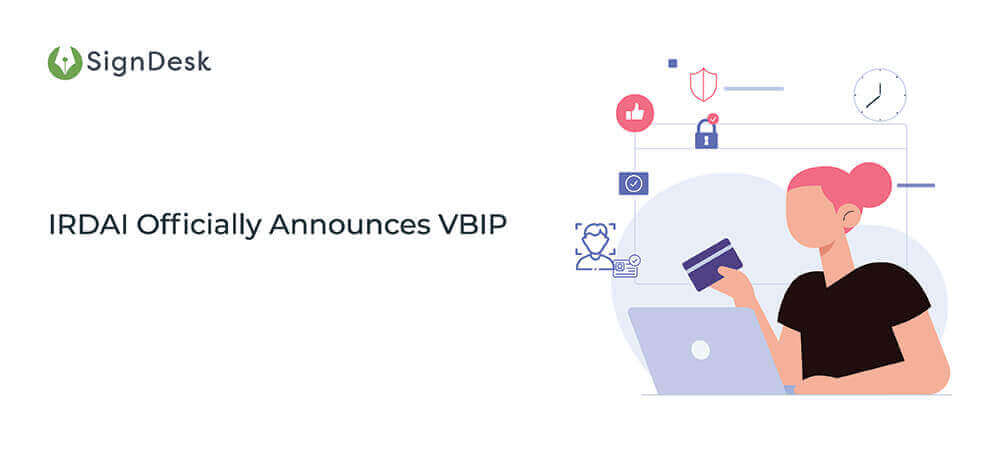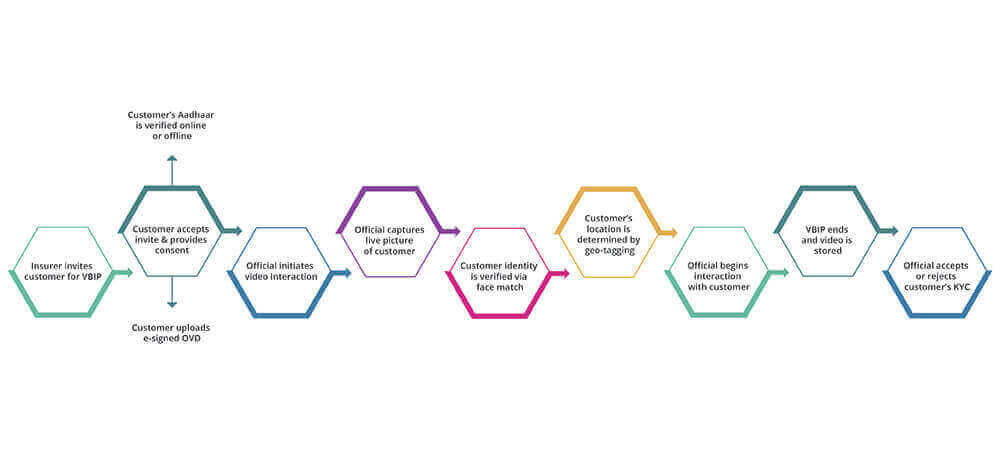VBIP
Following the release of a private circular to general, life, and standalone health insurers announcing its intent to envisage a video-based verification procedure, IRDAI has now officially announced the Video-based Identification Procedure (VBIP) for use by all life and general insurers.
The announcement comes off the back of both RBI and SEBI announcing their own video-based KYC procedures (V-CIP and VIPV respectively) and will make the KYC process simpler and more customer-friendly.
The digital nature of the new VBIP will ease the burden of KYC on both insurers and customers and will allow more people to obtain insurance during these fraught times.

What is VBIP and how can it be performed?
VBIP or Video-based Identification Process is an alternative KYC or identification process in which a trained official from the insurer conducts a face-to-face interaction with the customer to obtain KYC and other identifying information including KYC documents.
VBIP is to be conducted by the insurer on an application that facilitates the process. IRDAI has laid out rules regarding applications that may be used for VBIP –
- Insurers must carry out software and security audits of the application before rolling it out to ensure security, robustness and end-to-end encryption
- The application or APIs/web services used must undergo security testing through a CERT-In empanelled vendor
- The application must be end-to-end encrypted using minimum encryption standards such as AES 256
- The application must be hosted within India and must adhere to IRDAI cyber-security guidelines
What are the steps involved in VBIP?
The IRDAI VBIP circular illustrates the steps to be followed while conducting VBIP as follows.
- The customer’s consent must be obtained before initiating VBIP
- VBIP must be triggered from the domain of the insurer and not via a third party
- The authorized official will initiate a face-to-face video interaction with the customer and record the live video feed
- The official must ensure that the video quality is sufficient to recognise the customer beyond any doubt and that the customer’s face isn’t covered
- The official will collect identifying information from the customer as follows:
-
- Through online Aadhaar authentication, subject to the customer’s consent
-
- Through offline Aadhaar, i.e XML file or QR code, subject to the customer’s consent. In this case, the XML file or QR code must be no more than 3 days old at the time of VBIP. In both online and offline Aadhaar verification, the customer’s Aadhaar number is to be redacted or blacked out
-
- Through a digitally signed copy of an Officially Valid Document (OVD) issued to DigiLocker
-
- Through a photo or scanned copy of an OVD using eSign mechanism
- The official shall then ensure that the customer’s picture in the Aadhaar or OVD match the customer’s face in the video interaction
- The official will initiate an audio-visual interaction with the customer consisting of a sequence of randomized questions to ensure that the interaction is taking place in real-time
- The customer’s location must be determined via geo-tagging technology to be within India
- Once the interaction is concluded, the recorded video must be stored safely with date, timestamps, GPS coordinates and other necessary information
- The activity log of the interaction must be maintained along with the details of the authorized official
- Any account opened via VBIP will only be activated following verification and audits
- Finally, the insurer must make sure that the process is seamless, end-to-end encrypted, and real-time by carrying out liveness checks and making use of AI technology for facial matching and identity verification
What will VBIP look like in practice?
Given all this information, we can make an educated guess as to what VBIP will look like when insurers roll out an application.

VBIP for quick & cost-effective onboarding
Insurers and customers can both expect numerous benefits from VBIP. Banks & NBFCs, who have been onboarding customers via SignDesk’s V-CIP product have experienced 90% reductions in onboarding costs, 99% reductions in TAT, 20% reductions in KYC drop-offs, and increased customer acquisition.
Here’s what insurers can expect from VBIP.
- Reduced onboarding and KYC costs
- More accounts opened quickly
- Reduced documentation costs
- Increased market penetration and reach
- Increased customer satisfaction and acquisition
- More KYC completions
- Safer insurance onboarding
SignDesk allows insurers to perform VBIP securely and seamlessly, using cutting-edge facial matching and data verification technology. We use industry-grade security protocols to ensure customer data security and have been awarded the Global Banking & Finance Review’s Best Digital KYC/ Onboarding Product of 2020 in India.
Our video KYC solution is in use by several leading institutions who have all reported extensive growth and improvements thanks to our completely digital and automated onboarding product.
Onboard customers using VBIP now by booking a free demo with us!